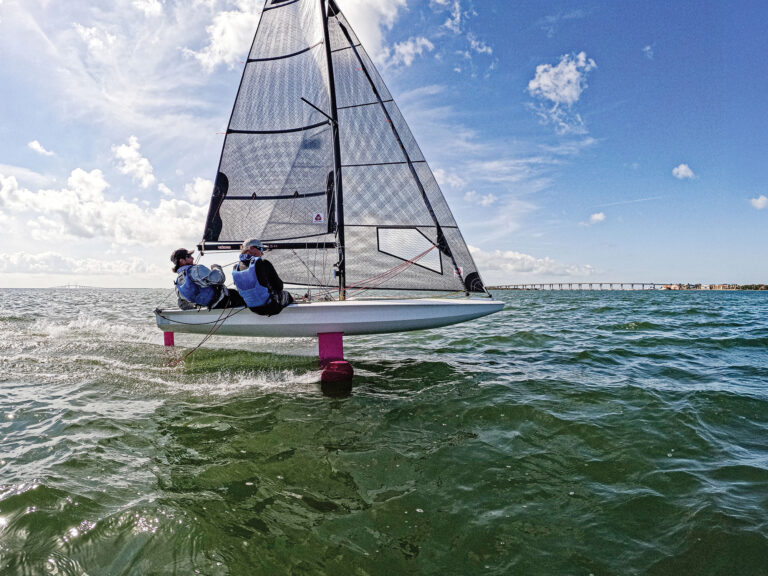
RoseMarkTackingStory
In the last two issues, I’ve explored the risks and rewards of certain moves you might make while rounding a mark. This month I’ll consider how the rules cover tacks made near marks.Most tacks near a mark are made either in the vicinity of a windward mark or at the end of the rounding of a leeward mark when the next leg is a beat to windward.The first diagram shows Peter, Paul, and Mary approaching a windward mark that they must leave to port. Consider the situation from Paul’s point of view. The rules apply to pairs of boats, so we must consider both Paul’s rights and obligations with respect to Peter, as well as his rights and obligations with respect to Mary.At position 1, Paul reaches the two-length zone clear ahead of Peter, at which time Rules 18.2(c) and (d) give Paul very strong rights. He has right of way over Peter and may change course to round the mark as rapidly as he likes with no constraint from Rule 16.1. In addition, if Peter manages to obtain an inside overlap on Paul, Peter is not entitled to room and, if Peter becomes overlapped outside Paul, Peter must give Paul room to round. Paul is in the catbird seat unless he turns past head to wind (see the last sentence of Rule 18.2(c)). Obviously, he will have to tack to round the mark and when he does, he will turn past head to wind. At that moment, Rule 18.2(c) ceases to apply and Rule 13 begins to apply. Rule 13 requires Paul to keep clear of Peter until he is on a closehauled course.Now let’s consider Paul’s rights and obligations with respect to Mary. Because Paul is making a port-tack approach to the mark, he is long on obligations and short on rights. In positions 1 and 2, Rule 10 requires him to keep clear of Mary. If he turns past head to wind, Rule 13 applies, replacing Rule 10, but he must still keep clear of Mary until he is on a closehauled course. “Once he is on a closehauled course he obtains right of way under Rule 11. However, he must comply with Rule 15 by initially giving Mary room to keep clear and with Rule 18.3 by not causing her to sail above closehauled.If Mary were not present, and if Paul’s boat was heavy enough, there is a tactic that would allow him to round the mark ahead of Peter. At position 2 he could simply luff up to head to wind and hold that course until he was abreast of the mark. By not turning past head to wind he would maintain his rights under Rule 18.2(c), and Peter would be required to keep clear. Peter would likely sail behind Paul’s stern, at which point Paul would be able to complete his tack without breaking Rule 13. However, Mary is present, and so, Paul’s crew better have the mainsheet out of its cleat and ready to ease big-time so he can duck Mary’s stern.With both Mary and Peter present at position 2, I can’t see how he could possibly tack without breaking at least one rule, and perhaps as many as three. This is just one of many possible examples that vividly illustrate the risks of making a port-tack approach to a windward mark on a track that will require you to tack from port to starboard within the zone. If you must approach a windward mark on port tack, do it at least three lengths below the mark so that you can complete your tack to starboard outside the zone. Better yet, approach about six lengths below the mark and you’ll likely find a hole you can tack in and be able fetch.The second diagram allows us to study two situations that are common when boats are required to leave the windward mark to starboard. Jack is approaching the mark closehauled on starboard tack on a course that will take him just to leeward of the mark. Jill is on port and tacks to leeward of Jack between positions 1 and 2. While she is turning from head to wind to closehauled on starboard Jill is required by Rule 13 to keep clear of Jack. The moment she is on her new closehauled course, Jill obtains right of way under Rule 11. However, Rule 15 initially requires her to give Jack room to keep clear, and Rule 18.2(a) also requires her to give Jack room to round the mark. Rule 18.3 does not apply because Jack is not “fetching” the mark. A boat is fetching an object only if her course will take her past it to windward without changing tacks. Immediately after position 3, Jack will tack around the mark. Until Jack turns past head to wind, Rule 18.2(a) continues to apply. It requires Jill to give him room to round, including room to tack (see the preamble to Rule 18). However, the moment Jack turns past head to wind, he becomes a boat on port-tack (to understand this, study the definitions Tack, Starboard or Port, and Leeward and Windward). Because Jill will still be on starboard tack at that moment, the boats will be on opposite tacks. They are still on the windward leg and so Rule 18 ceases to apply (see Rule 18.1(b)) and is replaced by Rule 13. Under Rule 13 Jack must keep clear of Jill. This should not be a problem for Jack because his momentum during his tack will carry him away from Jill.Suppose the two are really close and that Jill holds her course while Jack tacks and, just after Jack turns past head to wind, the port corner of his transom hits Jill’s starboard side. Would that constitute a breach of Rule 13 by Jack? No, because it would demonstrate that before Jack turned past head to wind Jill was not giving him room to round the mark. (See Rule 18.2(a) and the preamble to Rule 18. ISAF Team Racing Call E2 covers a similar situation.) If that happened, Jill should be penalized for breaking Rule 18.2(a) and Jack should be exonerated under Rule 64.1 (b).The third diagram shows Al and Barb rounding a leeward mark. The next leg is a beat. Al reaches the zone clear ahead of Barb, and so Rule 18.2(c) provides him with all the protections that Paul had with respect to Peter in the first situation discussed earlier. Al is permitted to make a tactical rounding that, if successful, would put Barb in his backwind or blanket zone. However, his crew blows the spinnaker takedown and he ends up in position 2. Barb can sail any course she pleases before and during her rounding, provided that she complies with Rule 18.2(c). Initially she sails wide of the mark and then rounds up close to it so that she will end up with relatively clear air on Al’s weather quarter.Suppose the left side of the next beat has fresher wind and Al would like to tack right after position 2. Don’t try it Al! Barb, who remains clear astern during her rounding, is under no obligation to give Al room to tack. Because she does not overlap Al, her only obligation under Rule 18.2(c) is to keep clear of him, which she definitely does. If Al were to start a tack by luffing to head to wind, Barb could continue to round the mark and assume a closehauled course. If Al turned past head to wind Rule 18.2(c) would no longer apply, but Rule 13 would, and it would give Barb right of way. What’s more, the boats would be on opposite tacks on a beat to windward and, as Rule 18.1(b) states, no part of Rule 18 would apply. Al’s only protection, if he tacks, comes from Rule 16.1. This rule prohibits Barb from changing course in a way that deprives Al of room to keep clear of her. However, it does not begin to apply until Barb becomes the right-of-way boat when Al passes head to wind. By that time, Barb will probably be on a closehauled course in a position to block Al’s tack. Al should not risk a tack unless he is confident that he can complete his tack without breaking Rule 13.E-mail for Dick Rose may be sent to [email protected]









